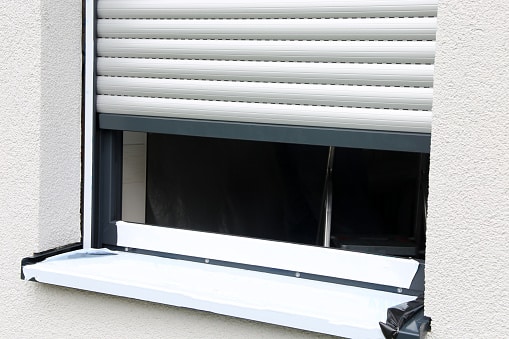Your roller shutter motor makes noise but doesn't turn, lDo you want to know how to tell if the capacitor is dead on a roller shutter? In our article, we'll be talking about electric roller shutter breakdowns, and whether or not the motor is out of order. And how to test a roller shutter motor.
You can ask a partner company for free information:
How to recognize a dead roller shutter
Is your roller shutter no longer working? Or do you think the motor is out of order? The truth is, like any appliance, the components of a roller shutter can fail. But if your roller shutter seems to be jammed, it could of course be the result of a malfunction. engine failure. Nevertheless internal parts of your roller shutter, such as the slats, the limit switches, the switch or even the control unit, can also be at the root of the problem.
So let's take a look at how to determine whether the problem is really with the engine, before deciding what to do about it.
How to check if your roller shutter motor is out of order?
First and foremost, it's important to check whether the malfunction comes from the motor. To do this, you need to check the condition of the fuses and wires.
- The simplest way is topress on the control (switch) and lend an attentive ear to the trunk at the top of the window, to see if the engine makes the normal noise it usually does when it's running well. If it does, then the motor is working perfectly and you'll have to look elsewhere for the problem.
- On the other hand, if the motor makes no noisethis means it is out of order or that the power supply is incorrect. To check that the motor is properly supplied with electricity, use a electronic tester to measure the voltage across the wires. This voltage must be around 220 V.
Otherwise the motor is poorly supplied due to a blown fuse or faulty cable.
But if it is 220V power supply and makes no noise this really means that your engine is really out of order.
You can ask a partner company for free information:
What causes defective roller shutter motors?
Roller shutter motors are tubular motors that are connected to a shutter shaft and transmit their power directly to this shaft. Most electric motors are so-called "capacitor». Capacitors are cylindrical components whose service life depends on factors such as humidity and ambient temperature. Capacitors are electronic components that can wear out quickly and are considered a standard problem when the motor fails. In 90% of cases, the cause of a roller shutter that no longer works is a defective motor capacitor.
How to easily know if the motor capacitor of your electric roller shutter is worn?
In fact, the only way to be sure that the capacitor is worn out is to measure capacitor capacity with a multimeter. But as you know, not everyone can use a multimeter, or even dismantle a shutter motor. Here are some tips on how to recognize a defective motor capacitor in your shutter without dismantling it.
Your roller shutter no longer goes up
When you give an order to raise your roller shutter, it stalls. Most often 30 cm from the bottom of the window. But by giving the apron a little push, the engine manages to lift easily and ensure the descent. In this specific case, the capacitor has lost part of its capacitance and is unable to provide the power needed by the motor to raise the deck. The thing to do is simply change the capacitor and the motor will go back to normal operation.
Your shutter neither goes up nor down
At this point, you will notice that the shutter does not move up or down. Either your capacitor is completely chair (short-circuited), or the electro-brake is blocked and unable to start the engine.
- In the first case, the motor will make a purring soundThis may mean that the fault is in the capacitor. But there's a 50% chance of this being the case. The best thing to do at the moment is to replace the whole motor.
- In fact, in the second case, you will hear a soft click every time you switch the shutter on or off. But if you press the remote control to switch the shutter on and off several times, the electro-brake will unlock and start the motor.
Your capacitor has deformations
Note that at this level, you need to remove the capacitor to check the condition of your capacitors. In fact, a capacitor deformed, perforated or even discolored is a sign of wear. Contrary to what you may read on other websites, capacitors can be worn and have no physical defect. This is particularly true of electric roller shutter capacitors. So, even if your capacitor is flawless, the only way to be sure it's in perfect condition is to measure its capacity.
How do I repair a damaged roller shutter motor?
To repair your roller shutter motor you must to change the worn capacitor or replace the motor in its entirety. But if you're not comfortable with DIY electronics, call in an expert after you've done a little diagnostics yourself.
Removal of the roller shutter motor
Dismantling an electric roller shutter motor is also feasible for the uninitiated. However, absolute caution should be exercised if you wish to attempt to replace the capacitor without specialist knowledge.
Capacitors can store large amounts of energy and are therefore life threatening even when the motor is unplugged. If you are not sure, better not touch it.
- Before removing the trunk surrounding the engine, be sure to turn off the power and either lower the apron down or block it
- Open the roller shutter box and remove the fasteners from the roller shaft apron.
- Remove the motor axle from the box, allowing the motor to be easily detached from the winding motor.
Change the capacitor or the entire motor
The motor capacitor is usually located outside of the roller shutter motor under a metal cover. Before opening, the power supply must be switched off.
And don't forget that even without electricity, this technique can be very dangerous. If a capacitor is faulty, all you have to do is replace it with a new one, which usually costs around €5. Then follow the same dismantling steps in reverse order to put the motor back in place and get your roller shutter running again.
On the other hand, if the capacitor is not faulty, you need to hire a professional to repair or replace the entire motor.
If, however, the roller shutter no longer works, intervening at the motor level will not be sufficient. The device must be replaced.
How much does it cost to repair an electric shutter?
Repairing a roller shutter requires the intervention of a skilled professional. The cost of repair can vary significantly, depending on factors such as the nature of the problem, the type of shutter and the cost of labor in your area.
- The most common failure concerns the motor of the electric shutter.
- Replacing a defective motor generally costs between 200 and 500 eurosincluding parts and labor.
- If the failure concerns the shutter apron (that is to say the blades that make up the shutter), it will take between 100 and 300 euros for the repair.
Similarly, if the problem comes from the rolling axis of the shutter, the cost of the repair fluctuates between 100 and 200 euros. Note that these prices are given for information only. and may vary depending on the complexity of the work and the rates charged by the professional.
It is also possible that the problem is electronic. In this case, the repair may consist of replacing a faulty switch, remote control or control box. These repairs are usually less expensive, ranging from 50 to 150 euros.
If the repair requires the total replacement of the shutter, the cost can rise significantly. On average, a new electric roller shutter costs between 300 and 1000 euros, depending on quality, brand and model specifications. It's a substantial investment, but one that can pay for itself in the long term, thanks to the shutter's longevity and the energy savings it delivers.
It is therefore recommended to call on a professional to obtain an accurate quote, taking into account the specificities of your shutter and the exact nature of the failure.
You can ask a partner company for free information:










Non mi vedo riconosciuto nelle cause di malfunzionamento che descrivete.
Nel mio caso (avvolgibile in ferro in finestra di abitazione), il primo malfunzionamento che ha palesato era la serranda che non scendeva più completamente fino al inferiore limit. In compensation poteva risalire. Interrotta la risalita però non semper, anzi semper di meno riusciva a scendere al livello precedente. Facendolo invece ancora salire, a un certo limit (non semper uguale) poteva dinuovo scendere, ma non come prima, e comunque mai fino a fine corsa inferiore
. Ripetendo l'operazione si ripetevano anche gli effetti peró un semper nelle distanze di prima. Anzi, a parte un'eccezione, a ogni prova, illimite di discesa si alzava semper di piu. In questo momento, per trovare il "fine corsa" superiore, l'ho fatto salire semper di più firming up definitively at the limit of the deragliamento in alto da dove non scende più.